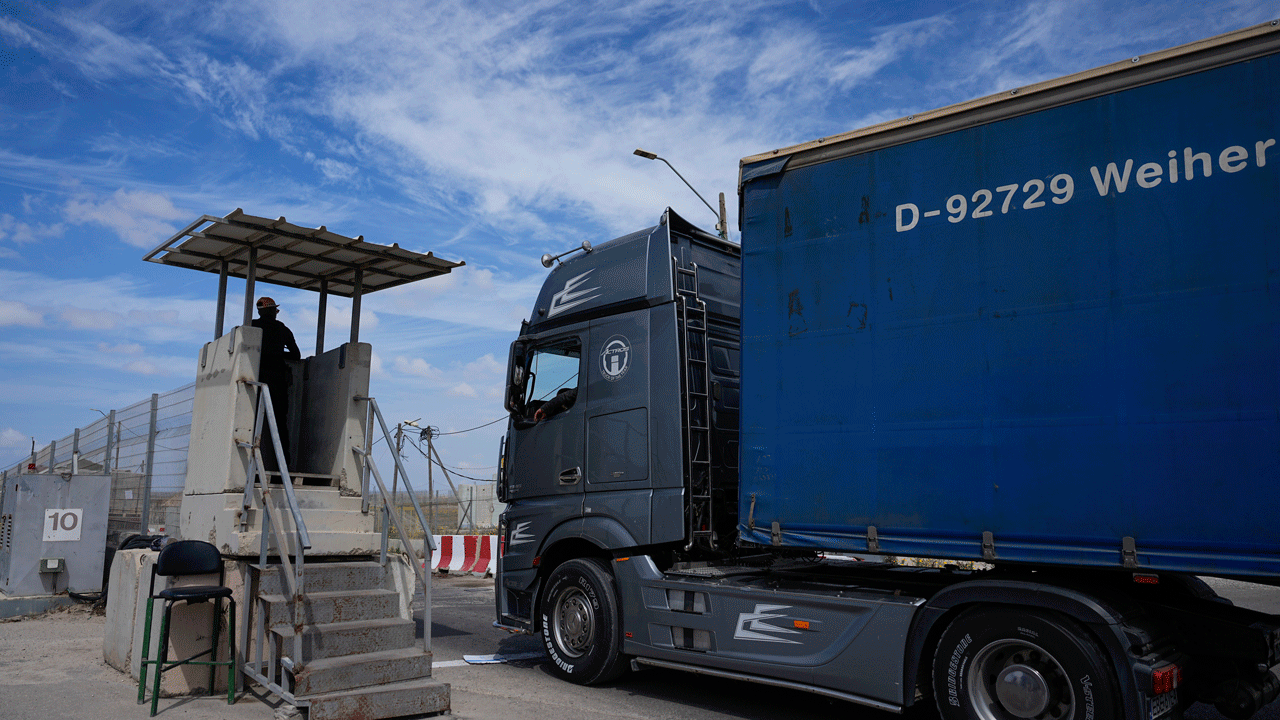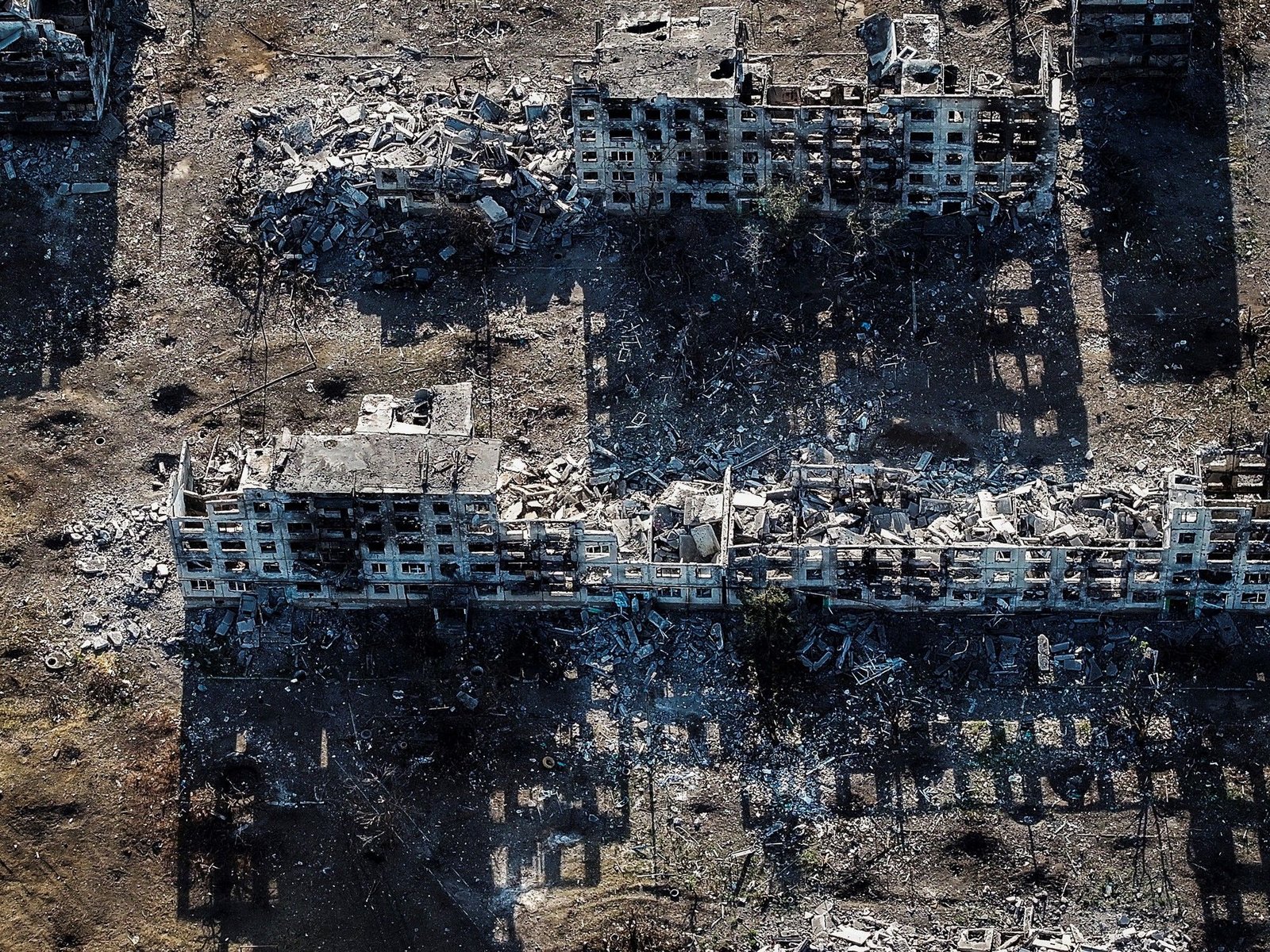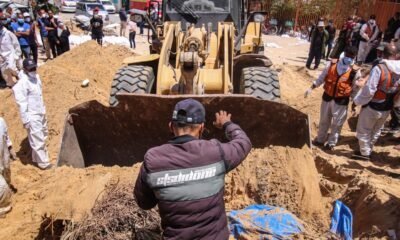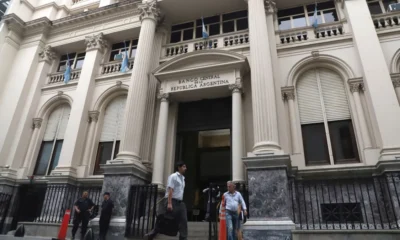INTERNACIONAL
More aid is supposed to be entering the Gaza Strip. Why isn’t it helping?

JERUSALEM (AP) — Under heavy U.S. pressure, Israel has promised to ramp up aid to Gaza dramatically, saying last week it would open another cargo crossing and surge more trucks than ever before into the besieged enclave.
But days later, there are few signs of those promises materializing and international officials say starvation is widespread in hard-hit northern Gaza.
FAMILIES OF AMERICAN HOSTAGES IN GAZA URGE BIDEN TO ACT AFTER 6 MONTHS OF CONFLICT: ‘DON’T HAVE TIME’ TO WAIT
Samantha Power, administrator of the U.S. Agency for International Development, said this week she accepted «credible» reports that famine is now occurring in the area and urged Israel to take further steps to expedite humanitarian aid shipments.

A truck carrying humanitarian aid for the Gaza Strip passes through the Kerem Shalom Crossing in southern Israel, Thursday, March 14, 2024. Under heavy U.S. pressure, Israel has promised to ramp up aid to Gaza dramatically, saying last week it would open another cargo crossing and surge more trucks than ever before into the besieged enclave. But days later, there are few signs of those promises materializing, and international officials say famine is fast approaching in hard-hit northern Gaza. (AP Photo/Ohad Zwigenberg)
Power’s remarks echoed those of U.S. President Joe Biden, who said on Wednesday that Israeli efforts to increase aid were «not enough.»
While Israel says it has dramatically increased the number of aid trucks entering the territory, U.N. workers report only a slight uptick — possibly because they count trucks differently.
Here’s what we know about the aid entering Gaza, and why discrepancies in reporting persist:
HOW MUCH AID IS ENTERING GAZA?
Israel says that since Sunday it has transported an average of 400 trucks a day into Gaza and that aid is now piling up on the Palestinian side of the Kerem Shalom crossing, one of two major crossings into the territory.
But Juliette Touma, communications director for the U.N. agency for Palestinian refugees, known as UNRWA, said that while aid workers have noticed a slight increase in the amount of aid entering Gaza, it’s nothing close to the surge Israel is claiming.
On Monday, UNRWA says 223 trucks of aid passed. On Tuesday, that number hit 246. On Wednesday, it was down to 141.
Meanwhile, only trickles of aid are reaching northern Gaza.
WHAT HAS ISRAEL PROMISED?
After Biden said last week that future American support for the war in Gaza depends on Israel doing more to protect civilians and aid workers, Israeli Prime Minister Benjamin Netanyahu promised a series of steps. Biden spoke out after an Israeli airstrike killed seven aid workers delivering food to the strip.
Netanyahu pledged to immediately re-open Israel’s Erez crossing into northern Gaza — a pedestrian crossing destroyed by Hamas militants when they stormed into southern Israel on Oct. 7. Netanyahu also said he would allow Israel’s port in Ashdod to process aid shipments and increase Jordanian aid packages through another land crossing.
But Israeli officials this week dropped the plan to open Erez. Instead, they say a new crossing will be built, though it is unclear when it will open. The Ashdod port, meanwhile, is not yet accepting aid shipments and Gaza aid groups report no significant increase in trucks received at their warehouses.
Before the latest Israel-Hamas war, some 500 trucks carrying food, fuel and other supplies entered Gaza daily. That was supplemented by fish and produce farmed within the territory.
Even that was barely enough in a crowded territory whose economy has been battered by a 17-year blockade imposed by Israel and Egypt. The blockade, meant to keep Hamas from arming, restricted the flow of goods in and out of Gaza and contributed to widespread poverty and unemployment.
Scott Anderson, the acting director of UNRWA in Gaza, said the low levels of aid since the war started have compounded an existing, pre-war nutrition deficit in the territory.
«You have to remember, this was not a nutrition-rich environment before the war. The resilience was not there,» said Anderson.
WHY IS THERE A DISCREPANCY BETWEEN THE UN AND ISRAEL’S NUMBERS?
Israel and the U.N. count trucks arriving in Gaza differently.
Israel counts every truck it inspects and allows to pass into Gaza, according to Shimon Freedman, a spokesperson for COGAT, the Israeli defense body in charge of Palestinian civilian affairs.
At the Kerem Shalom crossing, once the trucks pass into Gaza, the pallets of aid they are carrying are deposited in a 1-kilometer-long (a half-mile) zone for Palestinian drivers to pick up.
UNRWA only counts the trucks, driven by a Palestinian contractor, returning from that zone, Anderson said.
He also said that sometimes the trucks arriving from Israel are not fully loaded. Palestinian drivers on the Gaza side of the crossing load their trucks fully before passing through the gate — something that could further account for truck count differences.
WHAT IS SLOWING AID TRANSFER?
Getting from Israeli inspection, through the corridor and past the gate into Gaza takes time — and is made more arduous by the way Israel uses the Kerem Shalom crossing, Anderson said.
Since the war began, Israel has kept the crossing partially closed, Anderson said. Palestinian drivers must also wait for the incoming trucks to be unloaded — further narrowing the window of time allowed for pickup.
Aid inspected by Israel sometimes sits overnight, awaiting pickup. The U.N. says it stops all operations at 4:30 p.m. for safety purposes due to a breakdown in public order and airstrikes at night. UNRWA says they used to use local Palestinian police to escort aid convoys, but many refused to continue serving after airstrikes killed at least eight police officers in Rafah. Israel says armed Hamas militants have tried to siphon off aid.
COGAT denied allegations that they restrict the crossing’s hours or limit movement of trucks to pick up aid and blamed the U.N. for the backup, saying the agency does not have enough workers to move aid to warehouses for timely distribution.
WHAT HAPPENS MOVING FORWARD?
Israeli Defense Minister Yoav Gallant said Wednesday night that increasing aid efforts is a top priority.
«We plan to flood Gaza with aid and we are expecting to reach 500 trucks per day,» said Gallant. He did not specify a time frame for reaching that goal.
CLICK HERE TO GET THE FOX NEWS APP
But even if Israel meets its goal, slowdowns at the crossings and convoy safety concerns may continue to hamper distribution. The U.N. has called for a return to prewar procedures — with additional terminals open and a significant amount of commercial goods, in addition to humanitarian aid, able to pass through.
«Gaza has become very quickly dependent on relief handouts,» Touma said. «The market has been forced to shut. This is not sustainable.»
INTERNACIONAL
Ucrania pide poder atacar bases rusas con misiles occidentales para frenar el «terror» aéreo de Moscú

A las habituales peticiones de más defensas aéreas, Ucrania ha sumado una solicitud más ambiciosa que podría estar sobre la mesa en la cumbre que la OTAN celebra la semana que viene en Washington: que sus aliados le proporcionen más misiles de largo alcance y le permitan utilizarlos contra bases aéreas situadas dentro de Rusia.
El presidente ucraniano, Volodimir Zelenski, dio su último discurso a la nación después de que Rusia atacara a plena luz del día este miércoles la ciudad de Dnipró.
Seis personas murieron en el ataque y medio centenar resultaron heridas por los misiles. La aviación rusa también lanzó este miércoles bombas aéreas guiadas contra la ciudad de Khárkov, y sobre las posiciones ucranianas en la región homónima de la que la ciudad es capital.
«Sólo hay una forma en la que podemos parar esto: más sistemas de defensa aérea, más ataques a larga distancia a las bases de los terroristas rusos, a sus bases aéreas», dijo Zelenski en su alocución.
El presidente ucraniano agregó que está trabajando con sus socios en ambas cuestiones. Zelenski también mencionó los preparativos para la cumbre de la OTAN de la semana que viene en Washington.
Sin opciones de recibir una invitación en firme para unirse a la Alianza, Ucrania espera obtener de los países miembros otras concesiones que compensen este nuevo aplazamiento. El permiso para golpear bases rusas con sus misiles podría ser una de ellas.
Ucrania gana libertad de acción
Desde que los países de Europa y Norteamérica empezaran a enviar armamento a Ucrania después del comienzo de la invasión, las entregas de material militar llegaban hasta hace poco con una condición: que Kiev no lo usara contra territorio ruso.
Esta limitación impuesta por miedo a posibles represalias rusas provocaba frustración entre los ucranianos, que consideran injusta la prohibición de atacar las mismas instalaciones militares que el enemigo utiliza para golpear su territorio y la ven como un obstáculo que reduce sus posibilidades de ganar la guerra.
Aprovechando que Ucrania no tenía permiso para golpear con su mejor armamento las lanzaderas de misiles, los aviones y las concentraciones en su lado de la frontera, Rusia lanzó a mediados de mayo una ofensiva sobre la región nororiental ucraniana de Járkov.
La apertura de este nuevo frente despertó la preocupación en las capitales occidentales.
Algunos de los principales socios de Ucrania, como Francia y Estados Unidos, se sumaron al Reino Unido y a otros países «Halcones» que ya habían dado luz verde a los ataques ucranianos con sus armas en suelo ruso y eliminaron ciertas restricciones.
Pese a limitarse a objetivos situados cerca de la frontera, el permiso de Washington ha reducido la presión sobre las tropas ucranianas que defienden el norte de Khárkov y ha mejorado la situación de seguridad en la capital regional, que ahora es atacada con mucha menos frecuencia.
Como ha venido ocurriendo desde el comienzo de la guerra, la insistencia ucraniana y el miedo a que Rusia consiguiera una ventaja decisiva llevaron a parte de la coalición internacional que apoya a Ucrania a rectificar y a dar un paso antes impensable.
Ucrania confía en que, una vez más, pase lo mismo con su petición de poder golpear con misiles de largo alcance bases aéreas en toda Rusia.
La amenaza de las bombas aéreas
Si los drones y misiles pueden ser destruidos con los sistemas antiaéreos occidentales que siguen llegando gradualmente a Ucrania, las bombas aéreas guiadas son prácticamente imposibles de interceptar una vez han sido lanzadas desde cazas rusos.
Las bombas aéreas son explosivos convencionales con gran capacidad de destrucción que están dotados de sistemas de navegación propios. Esto permite que puedan lanzarse desde decenas de kilómetros de distancia del objetivo, sin que los aviones desde los que se deslizan entren en la zona de alcance de las defensas aéreas enemigas.
Para poder derribar estos aviones, Ucrania debe desplegar sus sistemas aéreos de más alcance muy cerca de la línea del frente, lo que eleva el riesgo de que sean destruidos por el enemigo. Transferir estos sistemas occidentales cerca de la línea de contacto supone, además, dejar desprotegidas otras zonas en que se necesitan.
Kiev considera más práctico destruir los aviones y los aeródromos que utilizan, para lo que necesita los misiles de alta precisión y largo alcance que recibe de Occidente.
Además de matar civiles, las bombas aéreas son uno de los instrumentos clave en los avances lentos pero sostenidos que está logrando Rusia desde el pasado otoño.
Este tipo de armamento sirve para destruir las posiciones ucranianas y los edificios que las tropas de Kiev utilizan como parapeto para defender pueblos y ciudades en el frente. Una vez convertidas en paisaje lunar, las sucesivas oleadas de carne de cañón rusas utilizan su superioridad numérica para avanzar y conquistar más terreno.
-
POLITICA2 días ago
La reacción del Gobierno ante la suba del dólar blue: “No vamos a devaluar ni a corrernos del plan de Caputo”
-
POLITICA2 días ago
Tras la tensión diplomática, Lula quiere eliminar el acuerdo automotriz con Argentina
-
POLITICA3 días ago
Milei respondió el comunicado de Bolivia, insistió en que fue “un golpe montando” y criticó a Lula Da Silva
-
ECONOMIA3 días ago
Por la caída de la actividad económica, el superávit de Milei y Caputo está en riesgo
-
ECONOMIA2 días ago
Para el economista Orlando Ferreres, Luis Caputo anunció «un Plan Bonex con otro nombre»
-
POLITICA2 días ago
Gesto de Milei a Mauricio Macri: el Gobierno resigna su representante en la AGN y se lo cede al PRO









































